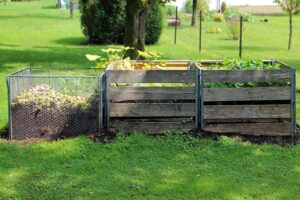Introduction
I live in an area with no trash pick-up. That makes composting very necessary for me. While some may find the absence of regular garbage collection inconvenient, I have come to embrace the opportunity it presents to engage in the power composting. Composting is not only an effective way to manage organic waste but also a means to create nutrient-rich soil for gardening and reduce the overall environmental impact of waste. In this article, I will guide you through the process of and the power of composting, enabling you to turn your organic waste into a valuable resource.
What can be Composted

First it’s essential to understand what can be composted. Organic materials such as fruit and vegetable scraps, coffee grounds, tea leaves, yard waste (like grass clippings and leaves), and even shredded paper can all be composted. However, it’s important to avoid adding meat, dairy products, oily food waste, or pet waste, as these items can attract pests or introduce harmful bacteria into the compost.
To begin composting, you’ll need a compost bin or pile. This can be as simple as a designated area in your backyard or a purpose-built container. Choose a location that receives partial sunlight and has good airflow. The compost pile should ideally be about three feet wide, three feet tall, and three feet deep, as this size promotes proper decomposition. You can keep several piles going if you have the room. In my case I set up three chicken wire bins to keep critters and my dog out of it. But you can just put the piles on the ground.
Next, it’s important to create a good balance of “greens” and “browns” in your compost. Greens refer to nitrogen-rich materials like fresh grass clippings and kitchen scraps, while browns are carbon-rich materials such as dried leaves and shredded paper. Aim for a ratio of roughly three parts browns to one part greens. This balance provides the necessary nutrients and carbon for the composting process.
As you add organic waste to your compost, be sure to chop or shred larger items to speed up the decomposition process. It’s also beneficial to periodically turn the compost with a pitchfork or shovel. Turning the compost aerates it, helping to break down the materials faster and preventing unpleasant odors.
Greens (Nitrogen-rich materials):
- Fruit and vegetable scraps
- Coffee grounds
- Tea leaves
- Fresh grass clippings
- Plant trimmings (non-woody parts)
- Weeds (without mature seeds)
- Seaweed
- Green leaves
Browns (Carbon-rich materials):
- Dried leaves
- Shredded paper (newspaper, office paper, cardboard)
- Straw or hay
- Wood chips or sawdust (untreated)
- Dry grass clippings
- Cornstalks
- Pine needles
- Eggshells
Remember, achieving a good balance between greens and browns is crucial for successful composting.
The Proper Moisture Level
Maintaining the proper moisture level in your compost is crucial. It should be moist, similar to a wrung-out sponge. If it’s too dry, sprinkle some water over the pile. Conversely, if it becomes too wet, add more browns to absorb excess moisture.
The Time Needed
The composting process takes time, typically several months to a year, depending on various factors such as the size of the pile, the materials used, and the environmental conditions. During this period, you may notice the compost warming up, which is a sign of microbial activity breaking down the organic matter.
It’s important to note that composting is a natural process, and you don’t need to add any additives or accelerators to your compost. However, if you want to speed up the process, you can occasionally add a thin layer of finished compost or high-quality soil to introduce beneficial microorganisms.
Once the compost is dark, crumbly, and earthy in appearance, it is ready to be used. This nutrient-rich compost can be added to your garden beds or potted plants, improving soil structure, water retention, and overall plant health. It’s an excellent alternative to synthetic fertilizers and provides a sustainable way to nourish your plants.
Conclusion
Living in an area without trash pick-up has taught me the value of composting. It not only reduces waste and promotes sustainability but also allows me to transform organic materials into a resource that supports my gardening endeavors. By following these simple steps, you too can embrace composting and make a positive impact on both your immediate environment and the planet as a whole.
For a deep dive on composting check my list of articles here.
For more on hot and cold composting click the link.
For a deep dive into the microbiology of composting click the link.
Resource: https://www.almanac.com/how-compost-guide-composting-home

